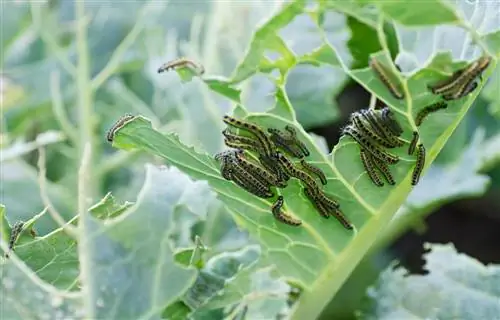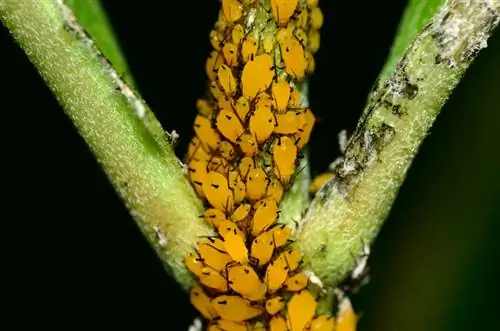- Author admin [email protected].
- Public 2023-12-16 16:46.
- Last modified 2025-01-23 11:22.
There are some caterpillars that target the crops in the garden. If there are no natural opponents, the voracious offspring of various butterflies spread uncontrollably and cause devastating damage. Harvest losses are not uncommon.

How can I control caterpillar pests in the garden?
You can combat caterpillars as pests in the garden by using protective nets, collecting the caterpillars, spraying them with water and growing mixed crops. Fragrant herbs such as garlic, basil, onions or oregano also help reduce damage.
Harmful images and combating them
Depending on the type of caterpillar, the pests attack above-ground parts of plants or roots. They feed on plant tissue, although the species prefer different plants. The larvae are often well camouflaged and difficult to detect. Traces of feeding, such as leaves eaten down to the leaf veins, indicate an infestation.
What helps against it
Protect the crops with close-meshed nets (€33.00 on Amazon) so that the butterflies cannot lay their eggs on the plants or the soil. It is usually enough to collect the caterpillars. You can transport these in a bucket and release them in a forest. If the pests have spread significantly, spraying them with a strong jet of water will help. Quickly collect the creatures lying on the ground. When growing, pay attention to mixed crops and plant fragrant herbs such as garlic, basil, onions or oregano in the bed.
Identifying harmful caterpillars
There are a number of butterflies and moths that feed on ornamental and useful plants in the early stages of development. Normally they do not pose a threat if natural predators are present.
cabbage white butterfly
The large cabbage white butterfly prefers to eat cruciferous vegetables, which also include the various types of cabbage. Its offspring can cause devastating feeding damage in summer. The small cabbage white butterfly is also dangerous for cabbage vegetables and nasturtiums.
Distinguishing features:
- Large cabbage white butterfly lays clutches of ten to 20 eggs
- its caterpillars are yellowish green and spotted black
- Small cabbage white butterfly places individual eggs
- velvety light green larvae hatch from this
Gamma Owl
This grey-brown moth is sometimes called the coal owl because they feed on vegetable cabbage. In addition, herbaceous plants such as tomatoes and lettuce or ornamental plants are on their menu. The caterpillars appear greenish or brownish and have a light yellow striped pattern.
Carbon cockroach
This butterfly is also known as the cabbage moth and develops from caterpillars that are up to nine millimeters long. They are colored deep green and have a brown head. When infested, cruciferous plants are heavily eaten away, so that only the skeleton of the leaves remains.
Small frost moth
The nocturnal butterfly places its eggs in cracks in the bark of trees. In spring, caterpillars hatch on it and are greenish in color with a dark green longitudinal stripe. Yellow horizontal stripes are typical, which make the larva appear segmented. They can cause major damage to deciduous trees and fruit trees because they eat away the leaf tissue down to the ribs.
cabbage borer
These butterflies can be recognized by their light brown and dark striped wings. Their yellow-green offspring resemble those of the more common cabbage moths. They live in loose webs on the underside of the leaves of various herbaceous plants and feed on the foliage.






